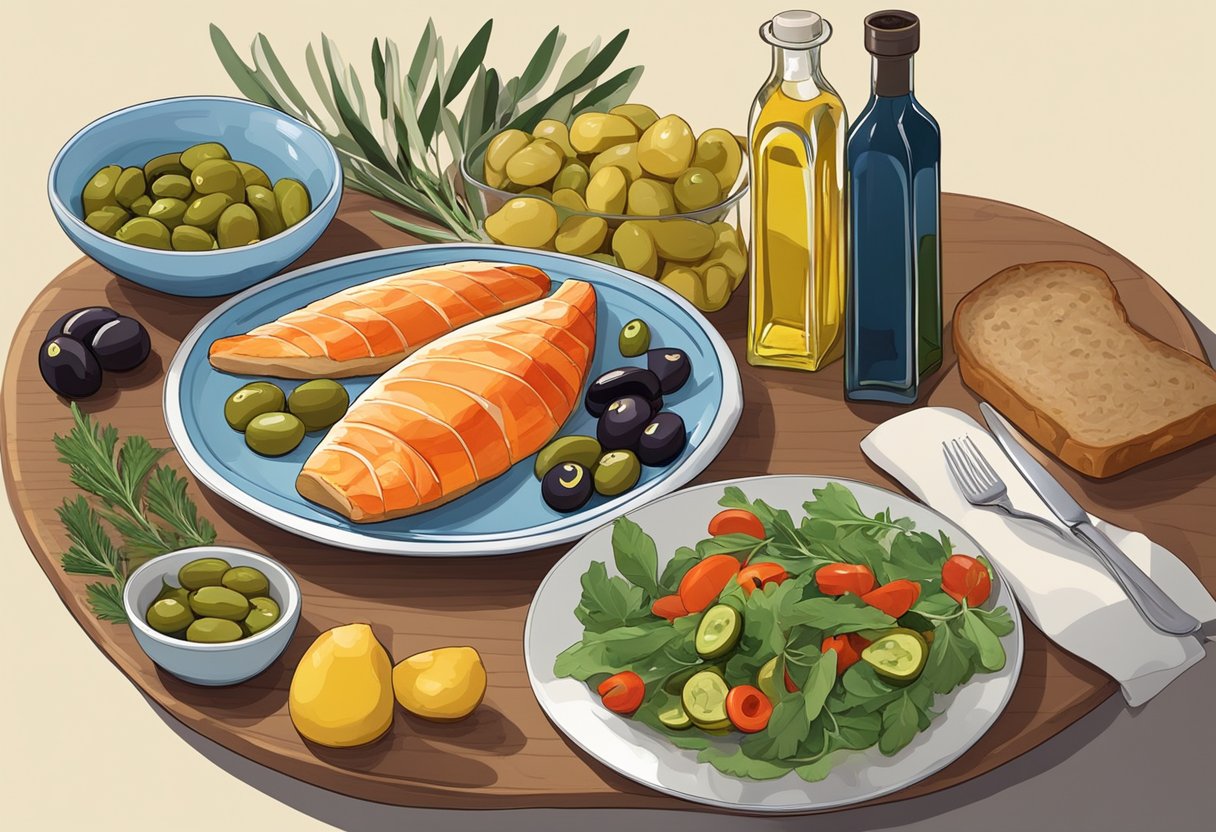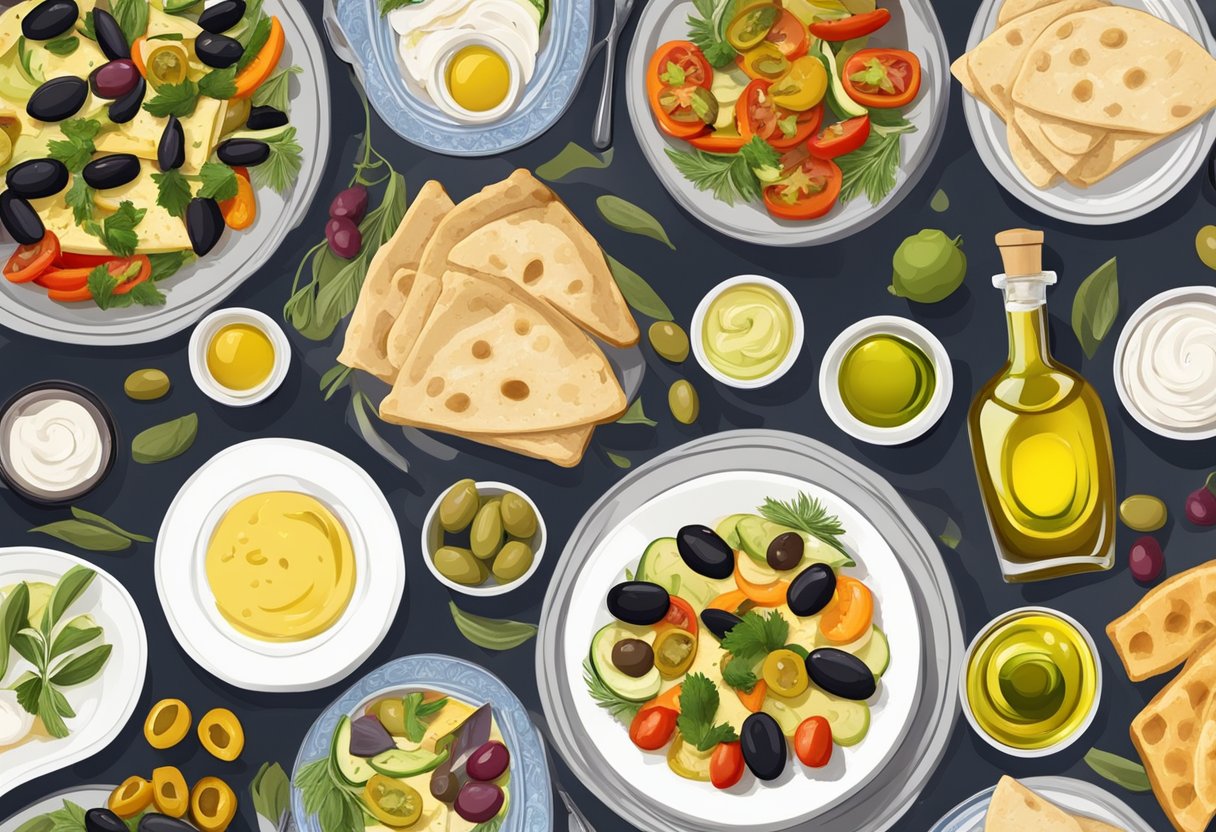Mediterranean cultures have long been celebrated for their typical meal patterns, which reflect both a rich cultural heritage and a beneficial dietary framework. Characterized by an emphasis on plant-based foods, the Mediterranean diet is a composite of the eating habits found in the countries surrounding the Mediterranean Sea.
This dietary pattern prioritizes fruits, vegetables, whole grains, legumes, nuts, and seeds, with olive oil serving as the principal source of fat. It incorporates moderate amounts of fish, seafood, dairy products, and poultry, while red meat is limited. Although not inherently gluten-free, it is easily adaptable to those with gluten sensitivities by emphasizing inherently gluten-free foods such as quinoa and rice in place of traditional gluten-containing cereals.

The health benefits of this diet are well-documented, with studies indicating a reduced risk of chronic diseases such as heart disease, stroke, and type 2 diabetes. The holistic approach of the Mediterranean lifestyle extends beyond nutrition, promoting physical activity and shared meals, further supporting overall well-being.
Environmental sustainability also intertwines with this diet, as minimally processed foods and seasonal produce are encouraged, reducing the ecological footprint. Moreover, modern adaptations have welcomed a gluten-free approach to this diet, making it inclusive for those with gluten intolerance or celiac disease, without compromising nutritional quality or taste.
Key Takeaways
- Embraces a variety of plant-based foods, with olive oil as a staple fat.
- Linked to significant health benefits and chronic disease prevention.
- Adaptable to gluten-free needs without sacrificing tradition or flavor.
Table of Contents
Historical Context and Origins
The essence of the Mediterranean diet is rooted in the eating patterns of the regions surrounding the Mediterranean Sea, characterized by a reliance on local produce, fresh seafood, and the use of olive oil. Evidence suggests that this diet has sustained the local populations for centuries, adapting over time while maintaining core nutritional principles.
Influence of the Mediterranean Sea
The Mediterranean Sea has been a major influence on the cultures of Greece, Italy, especially Southern Italy, and Spain. These regions relied on the sea for trade and the exchange of food ideas, cultivating a diverse array of foods that could thrive in the Mediterranean climate. Seafood became a staple protein source, fitting within a gluten-free framework. Local cuisines evolved to incorporate fresh fish and shellfish, integrating these items effortlessly into their gluten-free dishes.
Evolution of Dietary Practices
Over time, the dietary practices in Mediterranean cultures evolved to incorporate a cornucopia of local fruits, vegetables, and grains such as rice and corn, which are naturally gluten-free. In Greece and Italy, ancient traditions of agriculture supplemented the fish-based diet with ingredients like olives and figs. These practices have been passed down through generations, leading to a balanced diet that emphasizes fresh, seasonal, and local produce. In Southern Italy and Spain, the gluten-free aspect of the diet has been sustained through the prevalence of naturally gluten-free grains and the minimal use of gluten-containing products in traditional cooking.
Foundations of the Mediterranean Diet

The Mediterranean Diet is renowned for its emphasis on plant-based foods, healthy fats, and whole grains, forming a dietary pattern that is both flavorful and nutritious.
Key Components
In the Mediterranean Diet, olive oil stands as the primary source of fat, notable for its health benefits and central role in cooking practices. Fruits and vegetables are consumed in abundance, providing essential vitamins, minerals, and fiber. A variety of nuts and seeds, like almonds and sesame seeds, contribute to the diet’s high content in healthy fats and protein.
Whole grains, such as barley, rice, and products made with gluten-free flours serve as energy-rich staples. Legumes and beans, including chickpeas and lentils, are key sources of plant-based protein, making regular appearances in meals. Herbs and lemon often flavor dishes, reducing the need for salt.
- Protein: Predominantly from fish and seafood, providing omega-3 fatty acids, with red meat consumed less frequently.
- Dairy: Mainly from cheese and yogurt, enjoyed in moderate amounts.
- Pasta and bread: Integral parts but typically made with gluten-free grains to cater to those avoiding gluten.
- Wine: Often included, though consumed in moderation, primarily with meals.
Common Food Groups
Mediterranean meals are structured around the region’s abundant fruits and vegetables, with a focus on variety and seasonality. The diet’s plant-based nature is reflected in regular servings of vegetables like tomatoes, eggplants, and bell peppers, along with fruits such as figs, grapes, and citrus.
Proteins, largely derived from legumes, nuts, plant-based sources, and seafood underscore the diet’s low reliance on animal products. Grains, especially whole grains like brown rice and quinoa, form the dietary foundation, ensuring gluten-free options are available.
Olive oil, olives, and avocado provide healthy fats that are essential in a typical Mediterranean diet, while cheese and yogurt serve as supplementary protein and fat sources. Herbs and spices such as oregano, mint, and cumin are liberally used to enhance flavors without adding sodium.
Health Implications

A gluten-free Mediterranean diet is associated with significant health benefits, particularly concerning chronic disease prevention and management.
Cardiovascular Health
The gluten-free Mediterranean diet is rich in unsaturated fats from sources like olive oil and nuts, which have been shown to improve cardiovascular health. Studies indicate that higher adherence to this dietary pattern can lead to lower levels of LDL cholesterol and triglycerides, which are risk factors for heart disease and stroke. Specific components like fiber from fruits, vegetables, and legumes also contribute to maintaining a healthy blood pressure.
Obesity and Type 2 Diabetes
Obesity and type 2 diabetes mellitus are less prevalent among those following a Mediterranean dietary pattern. This diet emphasizes plant-based foods and unsaturated fats, linked to lower obesity rates. Such a dietary approach has been suggested to improve insulin sensitivity and reduce the risk of developing type 2 diabetes.
Cancer Prevention
The inclusion of high amounts of fruits, vegetables, and legumes, as well as the substitution of gluten-containing grains with gluten-free alternatives, provides antioxidants and fiber. These elements are crucial for cancer prevention by maintaining cellular health and reducing cancer risks.
Longevity and Aging
The gluten-free Mediterranean diet has been connected to increased longevity and healthier aging. Cohort studies have highlighted the correlation between this dietary pattern and a reduced mortality rate, likely due to the diet’s impact on reducing chronic disease risks, including cardiovascular diseases and diabetes.
Lifestyle and Eating Habits

The Mediterranean lifestyle incorporates a balanced approach to daily living that emphasizes wholesome eating habits and regular physical activity. It is not only about food choices but also about how meals are structured and the role of activity in overall health.
Meal Structure
The Mediterranean meal plan typically consists of three main meals—breakfast, lunch, and dinner—with lunch often being the largest. It is common to see:
- Breakfast: Light and usually consists of fruits, whole grains like oats, and coffee or tea.
- Lunch: The heaviest meal of the day featuring a variety of vegetables, legumes, and grains, with olive oil as a staple fat.
- Dinner: Smaller than lunch and may include similar components but in reduced portions.
For individuals following a gluten-free diet, traditional wheat-based pastas and breads are replaced with alternatives such as quinoa, rice, or gluten-free grains.
Physical Activity and Health
In Mediterranean cultures, physical activity is often seamlessly integrated into daily life:
- Exercise: Regular, moderate exercise such as walking, swimming, or cycling is a central component of the lifestyle.
- Health: Combined with the diet, this routine physical activity contributes to lower rates of cardiovascular diseases and other health benefits.
Each meal in the Mediterranean plan is approached not just as a time to eat but as an opportunity for social engagement and relaxation, which also plays a critical role in overall wellness.
Environmental and Sustainable Practices

The Mediterranean diet underscores the importance of eco-friendly agriculture and sustainable food production that focus on plant-based foods.
Agriculture and Food Production
Mediterranean cultures place a strong emphasis on sustainable agricultural practices that contribute to the preservation and enhancement of the environment. Core elements of this approach include:
- Crop Diversity: This system promotes a wide variety of crops, particularly gluten-free grains, legumes, fruits, and vegetables, integral to a gluten-free Mediterranean diet.
- Integrated Farming: Techniques such as crop rotation and green manure foster soil health and reduce the need for synthetic fertilizers.
- Water Management: Efficient irrigation techniques aim to conserve water, a precious resource in many Mediterranean regions.
- Organic Farming: Reducing the use of pesticides by adopting organic farming practices benefits the soil and local ecosystems.
Given that the Mediterranean diet is characterized by high consumption of plant foods, these agricultural methods not only ensure a consistent supply but also maintain the balance of the surrounding environment. They address both the nutritional needs of the community and the sustainability of the resources they depend on.
Modern Adaptations and Challenges

The Mediterranean diet, respected for its association with reduced risk of chronic diseases, faces new pressures in contemporary settings. These changes prompt adaptations that challenge the diet’s traditional beneficial elements.
Global Influence
Globalization has expanded the reach and influenced many dietary patterns, leading to the incorporation of novel food items into the Mediterranean diet. Researchers have observed that, while some changes bring variety, they can also lead to an increase in consumption of processed foods. The addition of gluten-free options within this diet reflects not only a response to celiac disease and other gluten sensitivities but also a popular trend that has been embraced globally. This influence requires careful consideration to maintain the balance between tradition and modernity to preserve the protective effect of the diet against chronic diseases.
Dietary Shifts and Processed Foods
Modern dietary shifts see a significant increase in highly processed foods, which stand in contrast to the historically minimally processed, plant-based foods fundamental to the Mediterranean diet. A meta-analysis of current eating habits within Mediterranean cultures indicates a drift away from the traditional consumption of fruits, vegetables, and whole grains, towards more processed options. This migration, often convenience-driven, can lead to a dilution of the diet’s healthy eating principles, undermining its role in the prevention of chronic diseases. It is critical for dietary guidelines to advocate for a reduction in processed foods, emphasizing the health benefits of plant-based foods inherent in the traditional Mediterranean patterns.
Culinary Traditions and Recipes
Mediterranean cuisine is known for its diversity and healthfulness, strongly influenced by the Mediterranean diet that emphasizes the use of olive oil, fresh produce, and whole grains, while limiting meats and dairy.
Regional Variations
Each region around the Mediterranean basin brings its own unique flavors and ingredients to the table. In the coastal areas, fish and seafood play a pivotal role, often grilled with a drizzle of olive oil and a sprinkle of herbs. Inland regions incorporate more poultry and eggs into their dishes. Across the board, fresh fruit is a staple dessert instead of sugary sweets, aligning with a gluten-free approach.
- Italy: Gluten-free pizza bases made from corn or sorghum flour are topped with fresh tomatoes, olive oil, and a selection of herbs.
- Greece: Spinach and cheese are encased in gluten-free phyllo for a twist on the classic spanakopita.
- North Africa: Couscous dishes, when made with corn instead of the traditional wheat semolina, cater to the gluten-free diet.
Preparation and Cooking Techniques
Traditional Mediterranean cooking techniques emphasize simplicity and the preservation of each ingredient’s natural flavors. Steaming and grilling are common, allowing for the reduction of added fats. Olive oil, a source of monounsaturated fats, is used both in cooking and as a dressing. It’s paired with garlic and herbs like rosemary and thyme to enhance, rather than mask, the flavor profile of vegetables and proteins.
- Marinating: Lean meats are often marinated in a mixture of olive oil, lemon juice, and spices before cooking to infuse flavor and tenderize.
- Yogurt-Based Sauces: Dairy products are used in moderation, with yogurt often serving as a base for sauces and dressings, providing a tart complement to dishes.
In sum, the Mediterranean diet’s focus on whole foods, prepared with minimal processing, aligns well with gluten-free dietary needs. Its rich use of varied vegetables, lean proteins, and flavorful herbs and spices creates a cuisine that is both healthful and enjoyable.
Nutritional Information and Guidelines

The Mediterranean diet emphasizes a plant-based approach, rich in fresh fruits, vegetables, whole grains, legumes, and nuts, all of which contribute to its high fiber content. It incorporates olive oil as a primary fat source and recommends protein through legumes and seeds, promoting weight loss and reducing cardiovascular risk factors.
Mediterranean Diet Pyramid
The Mediterranean Diet Pyramid serves as a guideline to the overall dietary pattern observed in Mediterranean cultures. It prioritizes:
- Daily consumption: Vegetables, fruits, whole grains, and healthy fats such as olive oil.
- Moderate amounts several times a week: Protein from legumes, seeds, and nuts; dairy products mainly in the form of cheese and yogurt.
- Limited intake: Red meat and sweets.
In the context of a gluten-free diet, whole grain choices within the pyramid would focus on those that do not contain gluten such as quinoa, buckwheat, and millet.
Portion Sizes and Frequency
Portion control is a key aspect of the Mediterranean diet, with an emphasis on small to moderate portions spread throughout the day. Guidelines suggest:
- Vegetables and Fruits: At least half of the plate at main meals.
- Whole Grains: 1-2 servings per meal, utilizing gluten-free options.
- Proteins: Legumes and seeds should be included daily, with portion sizes around ½ cup cooked legumes or a small handful of seeds and nuts.
Frequent, smaller meals are encouraged over large, infrequent ones to promote both weight management and steady energy levels throughout the day. The integration of plant-based, gluten-free proteins is key for those with gluten sensitivities or celiac disease, while still aligning with the traditional Mediterranean dietary pattern.
Scientific Research and Studies

Research on the Mediterranean diet consistently points to its benefits for health and longevity. This body of work comprises extensive epidemiological insights and clinical trials that align traditional Mediterranean eating patterns with lower incidences of chronic diseases.
Epidemiological Evidence
Researchers have established through numerous cohort studies that the adoption of a Mediterranean diet correlates with reduced mortality rates and lower occurrences of chronic conditions such as heart disease, type 2 diabetes, and cancer. A comprehensive meta-analysis demonstrated that a higher adherence to the Mediterranean diet offers a protective effect against cardiovascular risk and stroke. Evidence also indicates that this diet, rich in fiber from gluten-free grains, fruits, and vegetables, assists with weight loss and promotes the reduction of LDL (bad cholesterol) levels.
Clinical Trials and Nutritional Science
In controlled clinical trials, the Mediterranean diet, when adapted for a gluten-free lifestyle, has showcased its potential in healthy eating by reducing cardiovascular complications. The nutritional science behind this suggests that gluten-free whole foods, rich in antioxidants and anti-inflammatory properties, contribute to this heart-protective benefit. Additionally, the diet’s emphasis on healthy fats from sources like olive oil and nuts is central to maintaining balanced cholesterol levels, which plays a significant role in aging and overall health.
Public Health and Policy

Within the realm of public health and policy, the Mediterranean diet is often upheld as a model for preventing chronic diseases and promoting wellness through its heart-healthy and obesity-combating components.
Dietary Recommendations
The Mediterranean diet is frequently recommended by health professionals and policy makers and has been shown to provide numerous health benefits. This dietary pattern is rich in fruits, vegetables, whole grains, and healthy fats, notably olive oil. Cholesterol levels and cardiovascular risk factors improve when individuals follow this diet. Despite these advantages, adopting a Mediterranean diet free from gluten requires careful selection of grains to ensure adherence to both gluten-free needs and dietary patterns typical of Mediterranean cultures.
Health Promotion Initiatives
Public health initiatives emphasize healthy eating habits and physical exercise as pillars of chronic disease prevention. In Mediterranean cultures, these initiatives support dietary patterns that include an abundance of plant-based foods and fish, limited meat consumption, and the use of herbs for flavor instead of salt. For those dealing with obesity or aiming to maintain a healthy weight, the combination of a Mediterranean dietary pattern and gluten-free options can offer a sustainable path. Such initiatives advocate for a tailored approach to health promotion, ensuring that the core nutritional values of the Mediterranean diet are preserved, while also addressing specific dietary needs like gluten intolerance.
Frequently Asked Questions

In this section, the reader will find detailed information on the primary components, typical meal plans, excluded foods, the diet pyramid, staple foods, and adaptations for a vegetarian and gluten-free approach within the Mediterranean dietary pattern.
What are the primary components of a Mediterranean-style eating pattern?
A Mediterranean-style eating pattern is characterized by its high consumption of fruits, vegetables, whole grains—especially gluten-free options such as quinoa and brown rice—legumes, nuts, seeds, olive oil, and moderate intake of fish and poultry. It also includes a low consumption of dairy products, red meat, processed meats, and sweets.
Can you provide a 7-day meal plan typical of the Mediterranean diet?
One cannot provide a specific 7-day meal plan within this context due to the diverse nature of the Mediterranean diet. However, such a meal plan would typically feature a balance of gluten-free grains, a variety of vegetables and fruits, nuts, and lean proteins like fish and poultry, with each meal cooked and dressed with olive oil, accompanied by appropriate portions to maintain health.
Which foods are generally excluded from a Mediterranean diet?
The Mediterranean diet generally excludes highly processed foods, refined grains and oils, sugary beverages and desserts, and red and processed meats. In the context of a gluten-free Mediterranean diet, any product that contains gluten, such as traditional bread, pasta, and cereals made with wheat, barley, or rye, is also excluded.
What are the key elements of the Mediterranean diet pyramid?
The Mediterranean diet pyramid emphasizes whole fruits, vegetables, nuts, seeds, legumes, heart-healthy fats mainly from olive oil, and gluten-free grains. Fish and seafood should be consumed several times a week, while poultry, eggs, cheese, and yogurt in moderation. Meats and sweets are at the pyramid’s peak, suggesting infrequent consumption.
Could you list the top 10 staple foods integral to a Mediterranean diet?
The top 10 staple foods integral to a Mediterranean diet are: olive oil, legumes (like lentils and chickpeas), nuts (such as almonds and walnuts), seeds, fruits (for example, figs and grapes), vegetables (such as leafy greens and tomatoes), gluten-free whole grains (like quinoa and brown rice), fish, herbs and spices, and red wine in moderation for those who consume alcohol.
How does a vegetarian Mediterranean eating plan differ from the traditional diet?
A vegetarian Mediterranean eating plan differs from the traditional diet by eliminating fish and poultry, placing a greater emphasis on plant-based proteins such as legumes, nuts, and seeds, and increasing the variety and quantity of fruits and vegetables while still being gluten-free and adhering to the other principles of the Mediterranean diet.



